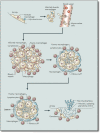Tuberculosis: what we don't know can, and does, hurt us
- PMID: 20466922
- PMCID: PMC2872107
- DOI: 10.1126/science.1184784
Tuberculosis: what we don't know can, and does, hurt us
Abstract
Mycobacterium tuberculosis has a penetrance of its host population that would be the envy of most human pathogens. About one-third of the human population would have a positive skin test for the infection and is thus thought to harbor the bacterium. Globally, 22 "high-burden" countries account for more than 80% of the active tuberculosis cases in the world, which shows the inequitable distribution of the disease. There is no effective vaccine against infection, and current drug therapies are fraught with problems, predominantly because of the protracted nature of the treatment and the increasing occurrence of drug resistance. Here we focus on the biology of the host-pathogen interaction and discuss new and evolving strategies for intervention.
Figures



References
Publication types
MeSH terms
Substances
Grants and funding
- R01 HL075845/HL/NHLBI NIH HHS/United States
- HL075845/HL/NHLBI NIH HHS/United States
- R01 HL071241/HL/NHLBI NIH HHS/United States
- HL092883/HL/NHLBI NIH HHS/United States
- R01 AI050732/AI/NIAID NIH HHS/United States
- AI067027/AI/NIAID NIH HHS/United States
- AI50732/AI/NIAID NIH HHS/United States
- ImNIH/Intramural NIH HHS/United States
- AI057086/AI/NIAID NIH HHS/United States
- R01 AI057086/AI/NIAID NIH HHS/United States
- HL100928/HL/NHLBI NIH HHS/United States
- R01 HL055936/HL/NHLBI NIH HHS/United States
- R01 HL100928/HL/NHLBI NIH HHS/United States
- R01 AI037859/AI/NIAID NIH HHS/United States
- R33 HL092883/HL/NHLBI NIH HHS/United States
- HL055936/HL/NHLBI NIH HHS/United States
- HL71241/HL/NHLBI NIH HHS/United States
- AI080651/AI/NIAID NIH HHS/United States
- R01 AI067027/AI/NIAID NIH HHS/United States
- R01 AI080651/AI/NIAID NIH HHS/United States
LinkOut - more resources
Full Text Sources
Other Literature Sources
Medical

